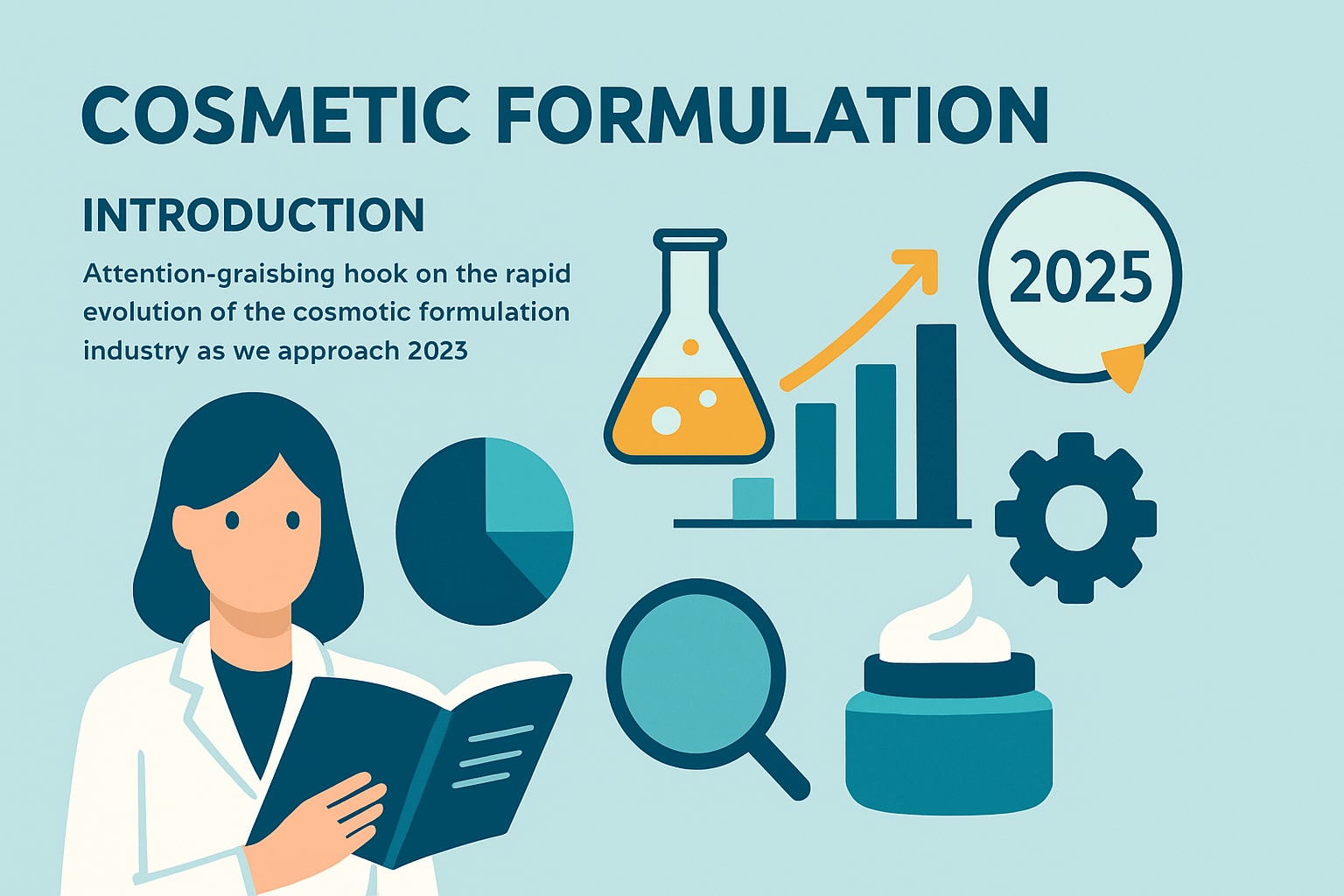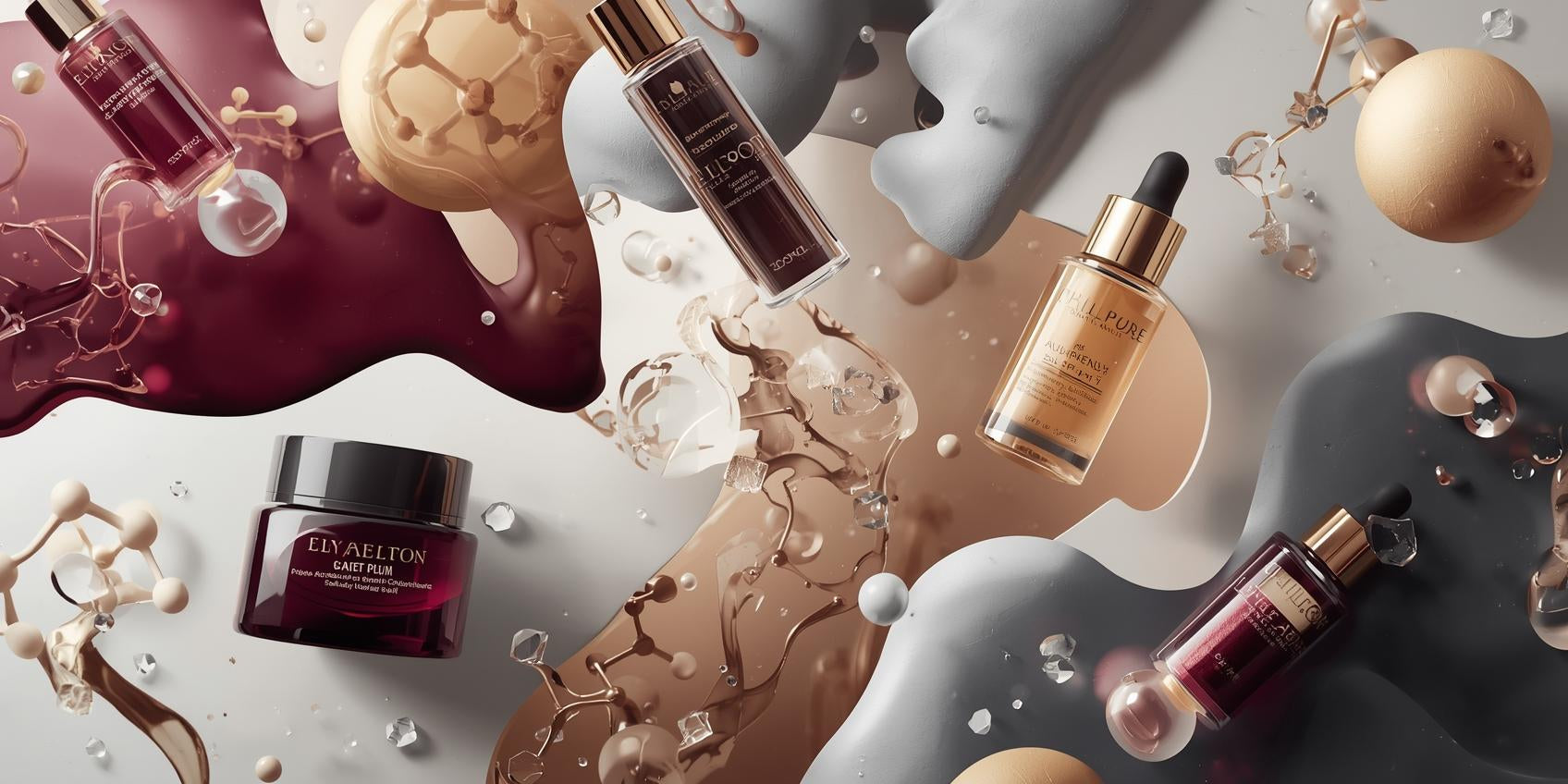Unlock radiant, healthy skin in 2025 with this essential beginner’s handbook for cosmetic cream. Whether you are new to skincare or looking to update your routine, this guide will demystify the world of skincare products and help you make informed choices. Discover what cosmetic creams are, how they work, and how to select the best one for your needs. Gain expert-backed insights, explore the latest trends, and learn practical steps to achieve flawless results. Start your journey to confident, glowing skin—no prior knowledge required.
What Are Cosmetic Creams? Understanding the Basics
Cosmetic cream is a cornerstone of modern skincare, trusted by millions for its ability to enhance and protect the skin. Whether you are new to skincare or looking to refresh your knowledge, understanding the basics of cosmetic cream sets the foundation for a confident skincare journey.
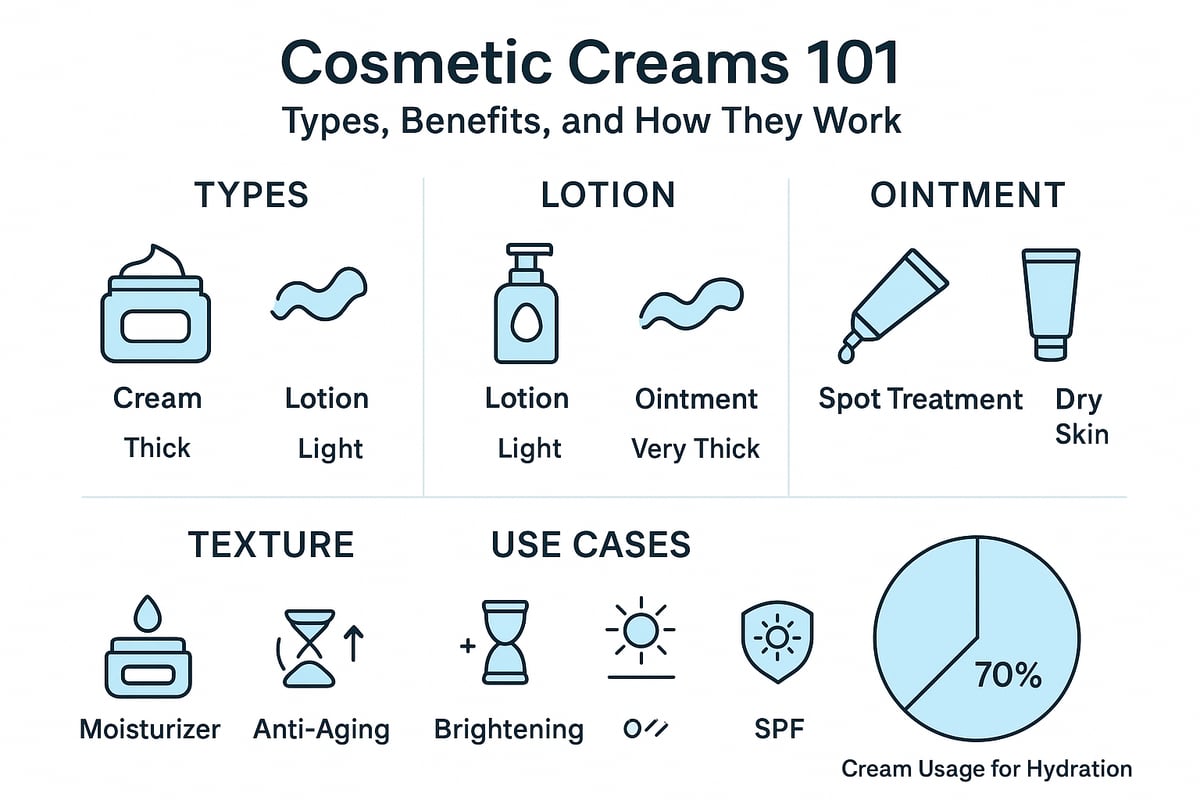
Defining Cosmetic Creams
A cosmetic cream is a topical product formulated to improve the appearance, texture, or health of the skin. These creams are thicker than lotions but lighter than ointments, which makes them versatile for daily use. The main difference lies in their water-to-oil ratio: creams have a balanced blend, lotions are more fluid, and ointments are dense and greasy.
| Product Type | Texture | Main Use |
|---|---|---|
| Cosmetic Cream | Medium | Hydration, repair |
| Lotion | Light | Quick moisture |
| Ointment | Heavy | Barrier protection |
Common uses for cosmetic cream include moisturizing, anti-aging, brightening, and sun protection. For example, a moisturizing cream hydrates, while a night cream targets repair. BB creams add a tint and SPF for multi-purpose care.
Types of Cosmetic Creams
There are several types of cosmetic cream, each designed for a specific skin goal. Categories include moisturizers, anti-aging creams, brightening formulas, sunscreens, and specialty creams for concerns like acne or sensitive skin. In 2025, multi-functional creams are gaining popularity, blending hydration, tint, and SPF in one product.
Trends show a surge in tinted moisturizers and hybrid SPF creams, making routines simpler and more effective. For a deeper dive into these innovations, check the 2025 cosmetic and skincare trends report for the latest market insights.
How Cosmetic Creams Work
Cosmetic cream works through several key mechanisms:
- Occlusion: Forms a protective layer to reduce moisture loss.
- Humectancy: Attracts water to the skin for deep hydration.
- Emollience: Softens and smooths the skin surface.
These processes strengthen the skin barrier and enhance resilience. Ingredients like hyaluronic acid act as powerful humectants, while ceramides help repair the skin’s natural defense. The result is skin that feels supple, balanced, and protected after regular cosmetic cream use.
Key Benefits of Using Cosmetic Creams
Using cosmetic cream offers multiple benefits:
- Hydration: Keeps skin soft and supple.
- Protection: Shields against environmental stressors.
- Targeted Treatment: Addresses specific concerns like aging or dullness.
According to a 2024 Mintel report, 68% of consumers apply cosmetic cream daily for hydration. This widespread adoption highlights the essential role creams play in maintaining healthy skin. Whether for daily moisture or specialized care, a cosmetic cream can transform your routine.
Who Should Use Cosmetic Creams?
Cosmetic cream is suitable for all skin types and ages, making it one of the most inclusive skincare products available. If you have dry, oily, combination, sensitive, or mature skin, there is a cosmetic cream formulated for your needs.
A common myth suggests that those with oily skin should skip creams, but the right lightweight formula can balance oil and prevent dehydration. People of any age can benefit, as cosmetic cream provides both immediate comfort and long-term results.
How to Choose the Right Cosmetic Cream for Your Skin
Choosing the best cosmetic cream can feel overwhelming with so many options on the shelves. However, a step-by-step approach will help you confidently select a product that suits your unique skin needs. Let us break down the process into simple stages so you can make an informed decision for radiant, healthy skin.
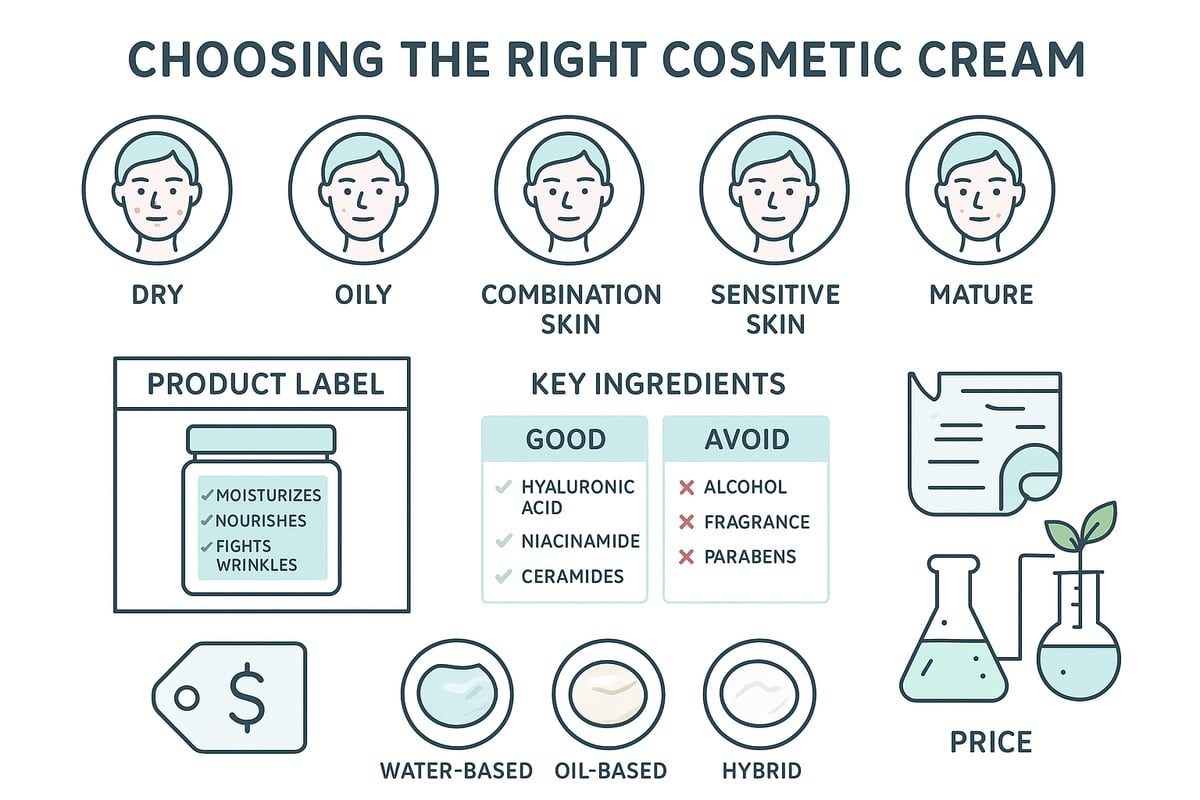
Assessing Your Skin Type and Needs
Begin by identifying your skin type, as this is the foundation for selecting the most effective cosmetic cream. Are you experiencing dryness, oiliness, sensitivity, or a combination of these? Mature skin may require different care compared to younger skin.
Perform a patch test before committing to any new cosmetic cream. Apply a small amount to your inner arm or behind your ear and wait 24 hours. This step helps you avoid irritation or allergic reactions. Understanding your unique skin concerns ensures that your chosen cosmetic cream addresses hydration, anti-aging, or other specific needs.
Reading Product Labels and Claims
Product labels can be confusing, filled with terms like “non-comedogenic,” “dermatologist-tested,” and “fragrance-free.” Learning to decode these claims makes it easier to choose a cosmetic cream that aligns with your goals.
Watch out for misleading phrases that sound scientific but lack regulation. For example, “hypoallergenic” is not a guarantee against allergic reactions. Always check the ingredient list and look for certifications that validate product claims. This habit will help you avoid disappointment and ensure that your cosmetic cream truly benefits your skin.
Key Ingredients to Look For (and Avoid)
The ingredients in your cosmetic cream determine its effectiveness and safety. Look for proven actives such as hyaluronic acid for hydration, niacinamide for brightening, ceramides for barrier support, peptides for firmness, and SPF for protection.
For sensitive skin, avoid parabens, sulfates, and certain synthetic fragrances. Many consumers now prefer products with natural or “clean” ingredients. To dive deeper, consult a Cosmetic cream ingredients guide for a comprehensive breakdown of what to seek out and what to avoid.
Understanding Formulation Types
Cosmetic cream formulations vary widely. Water-based creams are lightweight and absorb quickly, making them ideal for oily or acne-prone skin. Oil-based creams provide deeper moisture and are better suited for dry or mature skin.
Hybrid creams combine the best of both worlds, offering balanced hydration. Gel-creams, for example, are popular among those who want a non-greasy finish. Your skin type and climate can influence which formulation feels most comfortable and effective.
Price vs. Performance: Does Cost Matter?
Price does not always reflect performance when it comes to cosmetic cream. While luxury brands offer premium packaging and advanced ingredients, many drugstore creams deliver comparable results. Clinical studies often show that affordable products can match the efficacy of high-end options.
Consider your budget, but focus on ingredient quality and suitability for your skin. Sometimes, a modestly priced cosmetic cream with the right actives will outperform a costly alternative. Make your decision based on evidence, not just marketing.
[Custom Formulation Support: The INCI Lab]
If you have unique skin needs or want to stand out in the market, custom formulation labs like The INCI Lab offer tailored cosmetic cream solutions. These services create products based on your individual preferences, ingredient priorities, and sustainability values.
The INCI Lab guides you through ingredient selection, eco-friendly choices, and even provides full ownership of your formula. Personalized cosmetic cream development is ideal for entrepreneurs and brands seeking to make an impact with innovation and expertise.
Step-by-Step: How to Use Cosmetic Creams Effectively
Unlocking the full potential of your cosmetic cream routine requires more than simply applying a product. With the right approach, you can maximize absorption, target specific concerns, and avoid common pitfalls that may hinder results. Follow these expert-backed steps to ensure your cosmetic cream delivers the radiant, healthy skin you desire.
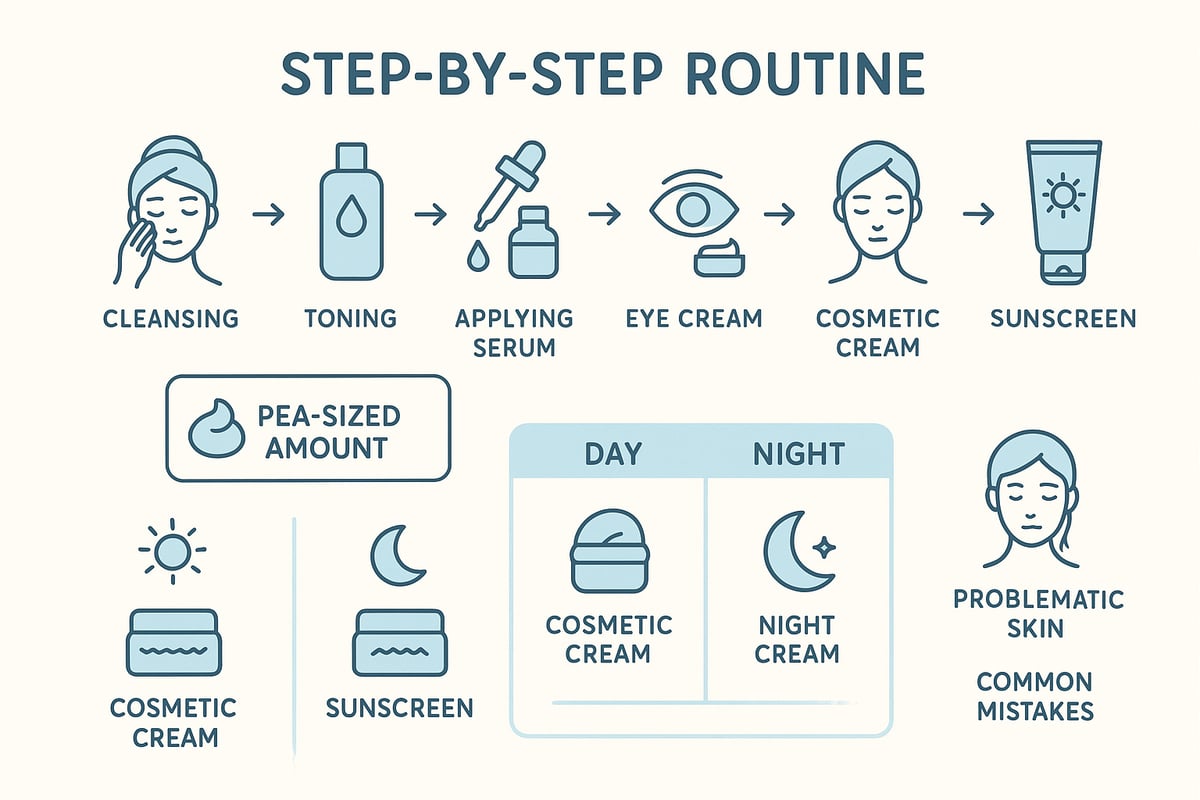
Prepping Your Skin
Start with a clean canvas to get the most out of your cosmetic cream. Cleansing removes impurities, excess oil, and makeup, which allows active ingredients to penetrate effectively.
For best results, consider double cleansing if you wear heavy makeup or sunscreen. First, use an oil-based cleanser to break down makeup, followed by a gentle water-based cleanser. Finish with a toner to rebalance your skin’s pH and create the ideal base for your cosmetic cream.
Application Techniques for Maximum Benefit
Applying cosmetic cream in the correct order ensures each product works as intended. Begin with serum, then eye cream, followed by your cosmetic cream. Always use a pea-sized amount to avoid overloading the skin.
Gently warm the cosmetic cream between your fingers, then massage it into your face using upward, circular motions. This enhances absorption and stimulates circulation, helping your skin look its best.
Frequency and Timing
Knowing when to apply your cosmetic cream matters. Use lighter, hydrating creams in the morning to prep your skin for the day, always finishing with sunscreen. Reserve richer or treatment-based creams, such as those with retinol, for nighttime routines.
Consistency is key. Apply your cosmetic cream at the same times daily to maintain hydration and achieve visible results. For active ingredients like retinol, stick to evening use to prevent sensitivity.
Layering With Other Skincare Products
Layering products correctly prevents pilling and boosts the effectiveness of your cosmetic cream. Wait at least 30 seconds between each layer to allow absorption.
If you use multiple products, apply from thinnest to thickest texture. Always read ingredient labels to avoid mixing actives that may irritate the skin. For more on how to decode ingredient lists, see Understanding INCI for skincare.
Special Considerations for Problematic Skin
If you deal with acne, rosacea, or eczema, adapt your cosmetic cream routine to minimize irritation. Choose formulations labeled as non-comedogenic and fragrance-free for sensitive or breakout-prone skin.
Before introducing a new cosmetic cream, patch test on a small area for several days. This simple step helps prevent unwanted reactions and ensures compatibility with your skin’s unique needs.
Common Mistakes to Avoid
Incorrect application can reduce the effectiveness of your cosmetic cream or even cause irritation. Avoid using too much or too little product, and never mix incompatible ingredients like strong acids with retinoids.
Dermatologists report that 40% of irritation cases are linked to improper use. Take time to read instructions, follow the recommended order, and always monitor your skin’s response to each cosmetic cream.
Decoding Cosmetic Cream Ingredients: What Really Matters
Understanding the ingredients in your cosmetic cream is essential for making informed choices. Ingredient lists can seem overwhelming, but knowing how to read them empowers you to select products that truly benefit your skin. Let’s break down what you should look for, what to avoid, and how to spot trends shaping the industry.
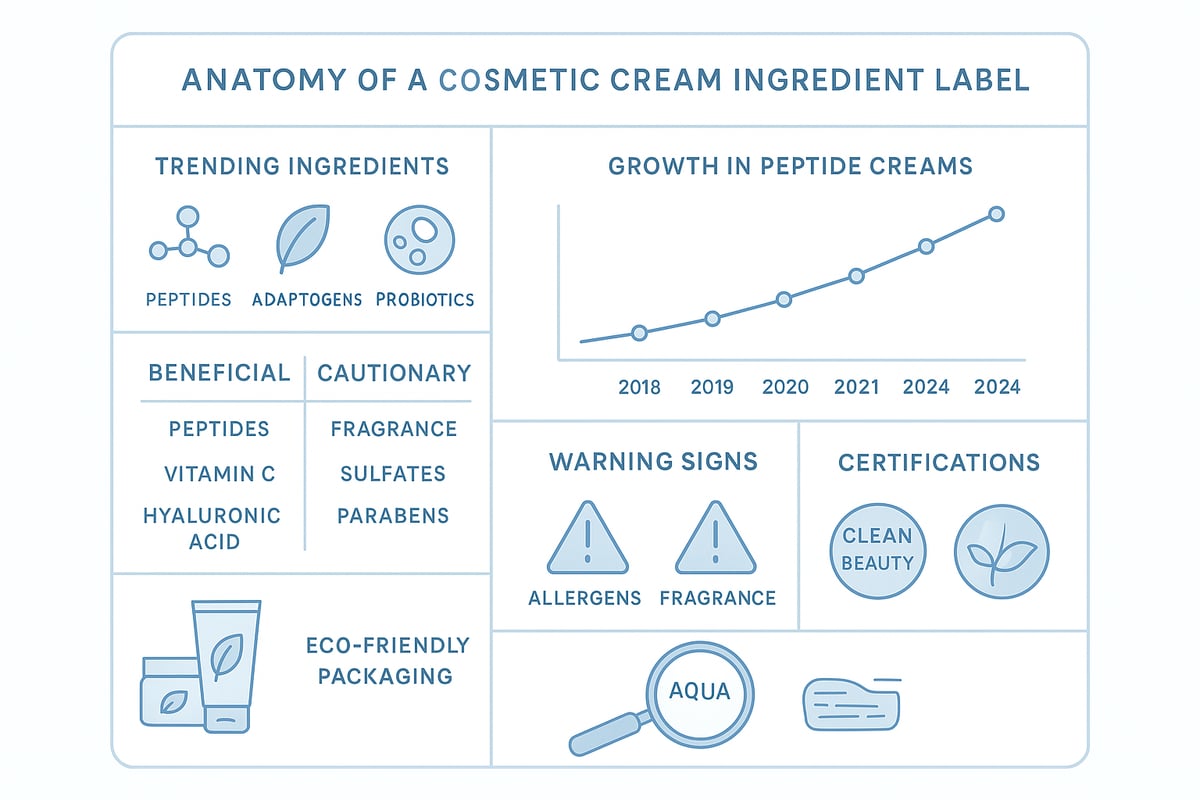
Understanding INCI (International Nomenclature of Cosmetic Ingredients)
Every cosmetic cream sold legally must use the INCI system, which lists ingredients by their standardized scientific names. For example, “aqua” appears instead of “water,” and “tocopherol” instead of “vitamin E.” This system ensures transparency, allowing users worldwide to identify what’s inside their cosmetic cream, regardless of brand or packaging language.
Reading an INCI list can help you spot both beneficial and potentially irritating ingredients. Ingredients are listed in descending order of concentration, so elements at the top of the list are most prominent. Familiarizing yourself with common INCI terms makes choosing a cosmetic cream much less intimidating.
Spotlight on Trending Ingredients for 2025
The cosmetic cream industry is rapidly evolving, with new actives taking center stage. In 2025, peptides are projected to see significant growth, offering support for collagen production and skin firmness. Adaptogens and probiotics are also gaining traction, targeting stress-related skin issues and promoting a balanced skin microbiome.
Sustainable botanicals, like bakuchiol (a plant-based retinol alternative), are increasingly found in cosmetic cream formulas. According to Euromonitor, peptide-infused creams are expected to grow by 18 percent this year, reflecting consumer demand for science-backed benefits.
Ingredients to Approach With Caution
While many ingredients in cosmetic cream formulas are safe, some require careful consideration. Essential oils, for example, can be highly sensitizing, especially for those with sensitive skin. Fragrances, both natural and synthetic, are common culprits for irritation.
It’s wise to be cautious with alcohol-based ingredients, which can strip moisture, and with certain preservatives that may cause allergic reactions. Always perform a patch test before introducing a new cosmetic cream, particularly if you have a history of skin sensitivities or allergies.
The Role of Preservatives and Stabilizers
Preservatives are critical in any cosmetic cream, as they prevent bacterial and fungal growth, ensuring safety throughout the product’s shelf-life. Without them, creams can become contaminated quickly, posing health risks. Common preservatives include phenoxyethanol and parabens, although the latter are being phased out in favor of gentler alternatives.
Stabilizers maintain the texture and consistency of your cosmetic cream, preventing separation or spoilage. As demand for “clean” products grows, many brands now opt for naturally derived preservatives that are both effective and skin-friendly.
Navigating “Clean Beauty” and Sustainability Claims
In 2025, “clean beauty” and sustainability are more than just buzzwords in the cosmetic cream market. Brands now emphasize natural ingredients, ethical sourcing, and eco-friendly packaging. Certifications such as COSMOS or Ecocert can help you identify genuinely sustainable products.
If you want a truly tailored approach, consider exploring custom cosmetic cream formulation services. These offer transparency in ingredient selection and let you prioritize sustainability and skin compatibility, ensuring your cosmetic cream aligns with your values and needs.
Pro Tips for Getting the Most Out of Your Cosmetic Cream
Unlocking the full potential of your cosmetic cream routine means more than just applying product. A few expert-backed tweaks can help you maximize results, keep your skin healthy year-round, and adapt to the latest advancements in skincare.
Maximizing Absorption and Results
To ensure your cosmetic cream delivers maximum benefits, focus on how you apply it. Start with clean, slightly damp skin for better penetration. Gently warm the cream between your hands, then use upward and outward strokes to massage it in. This method not only boosts absorption but also encourages circulation.
Consider tools like gua sha stones or facial rollers after applying your cosmetic cream. These tools can help evenly distribute the product and enhance absorption, especially around the jawline and cheekbones.
- Always use gentle pressure to avoid stretching the skin.
- Warm hands can help emulsify the cream for smoother application.
- Consistent massage improves product performance and relaxation.
Adjusting Your Routine With the Seasons
Your skin's needs change with the weather, so adapt your cosmetic cream routine accordingly. In summer, switch to lightweight, gel-based creams that provide hydration without heaviness. These formulas absorb quickly and prevent clogged pores in humid climates.
During winter, opt for richer, oil-based creams to combat dryness and protect the skin barrier. Remember to adjust your cosmetic cream amount as well, applying more in dry weather and less when humidity rises.
- Summer: gel creams, mattifying finish, SPF-infused formulas.
- Winter: thick emollient creams, barrier support, overnight masks.
- Spring/Fall: transition with hybrid or multi-functional creams.
Combining Cosmetic Creams With Other Skincare Products
Layering skincare is an art. Always apply cosmetic cream after lighter products like serums and before sunscreen during the day. Be mindful of ingredient interactions: some actives work well together, while others may cause irritation.
For example, avoid using retinol and vitamin C in the same routine, as they can increase sensitivity. Instead, alternate days or use vitamin C in the morning and retinol at night. Mixing your cosmetic cream with compatible actives, such as niacinamide or hyaluronic acid, can boost results without risk.
- Layer from thinnest to thickest product.
- Wait 30–60 seconds between layers for full absorption.
- Check ingredient lists for possible conflicts.
Storage and Expiry: Keeping Your Creams Effective
Proper storage extends the life of your cosmetic cream. Keep creams away from direct sunlight and extreme temperatures. Store products in a cool, dry place, and always close lids tightly to prevent contamination.
Check expiration dates regularly. Signs of an expired cosmetic cream include changes in color, texture, or scent. According to a 2023 Allure survey, 30% of users unknowingly use expired skincare, which can reduce effectiveness and cause irritation.
| Storage Tip | Why It Matters |
|---|---|
| Cool, dry location | Preserves ingredients |
| Tight lids | Prevents contamination |
| Avoid sunlight | Reduces degradation |
When to Consult a Professional
Sometimes, even the best cosmetic cream can cause unexpected reactions. If you notice persistent redness, itching, breakouts, or swelling, stop using the product and consult a dermatologist. These symptoms may indicate an allergy or sensitivity.
Patch testing new creams can help prevent adverse reactions. If issues persist or worsen, seek professional advice to tailor your routine safely. Never ignore ongoing irritation, as it could signal a deeper skin concern.
Staying Updated: Skincare Trends and Innovations for 2025
The cosmetic cream landscape is evolving rapidly, with new technologies shaping how we care for our skin. AI-powered skin analysis and smart creams are making personalized routines more accessible than ever. Brands are integrating microbiome support, adaptive textures, and even augmented reality tools for product selection.
For a deeper look at how artificial intelligence and augmented reality are transforming personalized skincare, explore AI and AR in Personalized Skincare. Staying informed about these trends ensures your cosmetic cream choices remain cutting-edge and effective.
Frequently Asked Questions About Cosmetic Creams
Navigating the world of cosmetic cream can spark plenty of questions for beginners and seasoned users alike. Below, you’ll find expert-backed answers to the most common queries, helping you make informed choices for your skincare journey.
Can I Use Multiple Creams at Once?
Yes, you can layer more than one cosmetic cream, but there are guidelines to follow for best results. Always apply creams from the lightest to the richest texture. For example, use a lightweight day cream in the morning and a richer night cream before bed. If you use a targeted cosmetic cream, such as an anti-aging formula, apply it before your moisturizer. Avoid mixing creams with conflicting actives, like retinol and exfoliating acids, in the same routine.
Layering cosmetic cream products can maximize benefits when done correctly. Always patch test new combinations to prevent irritation.
Are Natural or Organic Creams Better?
Natural or organic cosmetic cream options have gained popularity, but they are not always superior to synthetic formulas. Natural creams often feature plant-based ingredients and may appeal to those seeking “clean” beauty. However, synthetic ingredients can be more stable and less likely to cause allergic reactions for some people.
Studies show that demand for natural cosmetic cream products is rising, with a 45% market share in 2024 according to Statista. Ultimately, choose based on your skin’s needs, ingredient sensitivity, and performance rather than labels alone.
How Long Does It Take to See Results?
Results from a cosmetic cream depend on the type and purpose of the product. Hydrating creams may deliver visible plumping within hours, while brightening or anti-aging creams typically require several weeks of consistent use. Clinical trials show most users notice hydration improvements within a week, but anti-aging effects such as reduced fine lines may take 4–12 weeks.
Patience is key. Track your skin’s progress, and remember that using your cosmetic cream daily as directed is crucial for optimal results.
What Should I Do If I Have a Reaction?
If you experience redness, itching, or breakouts after using a cosmetic cream, stop application immediately. Gently cleanse the area and avoid using other active skincare products until your skin calms down. Consider applying a soothing, fragrance-free moisturizer.
For severe or persistent reactions, consult a dermatologist. Before trying a new cosmetic cream, perform a patch test on a small area of skin to help prevent future irritation.
Can Cosmetic Creams Replace Medical Treatments?
Cosmetic cream products are designed to improve the appearance and health of your skin, but they are not substitutes for prescription treatments. While some creams target concerns like acne or eczema, they cannot match the potency of pharmaceutical options.
If you have a diagnosed skin condition, consult a healthcare professional before replacing medical treatments with a cosmetic cream. Use cosmetic products as supportive care, not as a cure for medical issues.
How Do I Know If a Cream Is Right for My Age?
Choosing the right cosmetic cream depends on your age, skin type, and specific concerns. For younger skin, focus on hydration and sun protection. Mature skin often benefits from creams containing retinol, peptides, or ceramides for enhanced firmness and barrier repair.
Look for age-appropriate ingredients on labels, and adjust your cosmetic cream routine as your skin evolves. If unsure, seek advice from a dermatologist or skincare specialist.
Are Expensive Creams Worth the Investment?
Price is not always an indicator of quality when it comes to cosmetic cream. Many affordable options contain clinically-proven ingredients and deliver excellent results. Dermatologists often recommend drugstore creams with effective formulas over luxury brands with similar actives.
Evaluate a cosmetic cream based on ingredient list, formulation, and compatibility with your skin. Investing in a well-formulated product is wise, but high price alone does not guarantee better outcomes.
What’s New in Cosmetic Creams for 2025?
The cosmetic cream market is embracing exciting innovations for 2025. Expect to see waterless creams, refillable packaging, and AI-personalized formulas. Brands are also focusing on microbiome-friendly ingredients and eco-friendly packaging. According to Cosmetic Skin Care Market Growth Projections, the industry is set for significant growth, driven by demand for advanced formulations and sustainability.
For those interested in sustainability, Sustainability in Cosmetic Packaging highlights the ongoing shift toward recyclable and biodegradable packaging. Staying informed about these trends can help you make better choices when selecting your next cosmetic cream.
You’ve just taken the first step toward mastering the world of cosmetic creams—from understanding ingredients to choosing what’s best for your skin and applying it with confidence. If you’re ready to turn these insights into action and explore how you can develop your own standout product in the beauty market, I invite you to take the next step. Whether you are an entrepreneur or just passionate about skincare, you don’t have to navigate this journey alone—let’s make your vision a reality together. Start Your Product Journey


